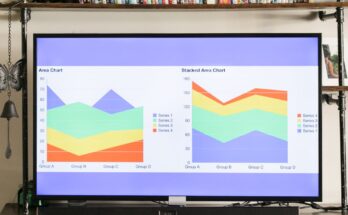Growing a business and making more sales can sometimes feel like trying to find your way through a maze blindfolded, right? You’re trying different things, hoping something works, but you’re not totally sure why some things click and others just… don’t. It can be frustrating, leaving you wondering if you’re putting your effort in the right places or talking to the right people. But what if there was a way to turn on a light in that maze? That’s where understanding and using the information you already have comes in. This article is all about how looking closely at the data around your business can give you clear directions, helping you understand your customers better, make smarter choices, and ultimately, boost those sales numbers without the guesswork. Let’s peek behind the curtain and see what your data’s been waiting to tell you.
What Exactly Are We Talking About When We Say ‘Data’?
Okay, let’s get clear on what “data” means in the sales world. It’s not some super complicated, scary computer stuff. Think about it like this: whenever someone interacts with your business, they leave little digital footprints. Data is just the collection of those footprints.
Imagine you have a lemonade stand. Data would be knowing things like: How many cups did you sell today? What time of day did most people buy? Did they pay with cash or a card? Did the kids prefer it sweeter than the adults? Did anyone ask for a slice of lemon with it? When we talk about business sales data, we mean things like: who bought what, when they bought it, how they found you, what emails they opened, what pages they looked at on your website, how much they spent, and so on. It’s all the little details that build a picture of what’s actually happening with your customers and your sales process.
Listening Closely to What Your Data Tells You
Having data is one thing, but actually understanding what it’s whispering (or sometimes shouting!) at you is the real trick. It’s like having a map but not knowing how to read the symbols. Looking at your data means looking for patterns and stories. For instance, does your data show that most people who buy your main product first looked at three specific pages on your website? Does it tell you that customers who buy product X also tend to buy product Y within a month?
Let’s use our lemonade stand example again. If your data shows you sell way more lemonade between 2 PM and 4 PM on hot days, that’s a pattern! It tells you maybe you should make sure you’re well-stocked and ready during those times. If you notice everyone who buys the extra-sour version also bought a cookie, maybe those two things go well together. Your data helps you stop guessing and start seeing connections that can point you toward smarter actions.
Finding Your Best Customers (And Why That Matters)
Not all customers are the same, right? Some might buy once and you never see them again. Others might become regulars, buying frequently and even telling their friends about you. Data is amazing at helping you figure out who those really valuable customers are. You can look at things like how often they buy, how much they spend, or even which customers came back after their first purchase.
Think of it like finding your best friends. You probably clicked with them because you have shared interests or get along well. Your sales data helps you see the ‘shared interests’ or characteristics of your most valuable customers. Maybe they all live in a certain area, work in a certain type of job, or first found out about you through a specific online ad. Once you know who your best customers are and *why* they’re great customers, you can use that information to find more people just like them. It’s way easier and often cheaper to find someone similar to a customer you already know is awesome than to try and sell to just anybody.
Crafting Offers That Actually Hit the Mark
Have you ever seen an ad online and thought, “Wow, it’s like they read my mind! I was just looking for that!” That often happens because companies are using data to figure out what you’re likely to want. Once you understand your customers better through data, you can stop making generic offers and start creating specific ones that are way more likely to grab their attention and lead to a sale.
Let’s say your data shows that people who buy kids’ shoes also tend to buy socks within a week. You could then create a special offer: “Buy any pair of kids’ shoes and get 20% off socks!” This isn’t a random guess; it’s an offer based on what your data suggests customers are already likely to need or want together. It feels more helpful and relevant to the customer, making them more likely to buy.
Connecting with Customers Where and How They Like It
There are tons of ways to talk to potential customers these days: email, social media, text messages, phone calls, maybe even carrier pigeons (okay, maybe not that last one). But how do you know which way is best for which customer? Data can give you hints!
Your data might show that younger customers mostly respond to social media messages, while older customers prefer email. Or maybe people who first found you through Google search are more likely to open your follow-up emails than those who came from a social media ad. By understanding these preferences through data, you can focus your communication efforts where they’re most likely to be seen and acted upon. It’s about sending the right message to the right person at the right time, using the channel they prefer. This makes your marketing feel less like spam and more like a welcome conversation.
Spotting Where Sales Might Be Slipping Away
Data isn’t just for finding successes; it’s also super helpful for finding problems. Sometimes, people start showing interest in your product or service, but somewhere along the way, they drop off and don’t actually buy. This is like someone walking up to your lemonade stand, looking at the menu, but then walking away without buying a cup. Your data can help you see where this is happening.
Maybe lots of people add something to their online shopping cart but don’t finish the purchase. Data can show you this “abandoned cart” rate. Or maybe lots of people click on your ad but leave your website right away. Data tells you that too. Pinpointing these drop-off points allows you to investigate *why* it’s happening. Is the price too high? Is the checkout process too complicated? Is the website confusing? Data helps you see the symptom so you can look for the cause and fix it, stopping those potential sales from slipping through your fingers.
Measuring What’s Working (And What Isn’t)
Okay, so you’ve used your data to identify your best customers, sent them a targeted offer, and reached out through their preferred method. Great! But did it actually work? Data gives you the answer. You can track things like how many people clicked on that offer, how many of them actually bought something, and how much money that specific effort generated.
This is like tracking how many extra cups of lemonade you sold *after* you put up a bigger sign advertising your special deal. Did sales go up significantly during the hours the sign was up? Data provides that feedback loop. It helps you see which of your sales and marketing activities are giving you the best results for the effort or money you put in. This way, you can do more of what works and less of what doesn’t, making your sales efforts much more efficient and effective over time.
So, there you have it. Moving from guesswork to growth often starts with paying attention to the story your data is telling you. It’s not about magic formulas or complicated tech you can’t understand. It’s about gathering the simple facts of how your customers interact with your business, understanding what those facts mean, and then using that understanding to make smarter choices. We talked about how data helps you define who your customers are, figure out what they want, decide how to talk to them, spot problems quickly, and see if your efforts are paying off. By using data as your guide, you can navigate the path to sales growth with much more confidence, making your business efforts more effective and your customers happier because you’re actually listening to what they’re showing you.




